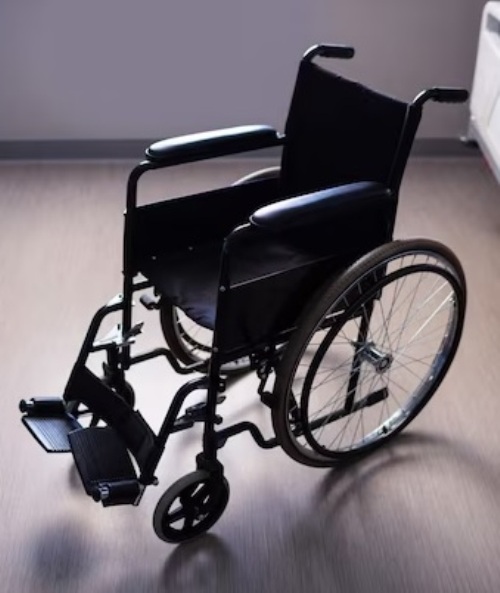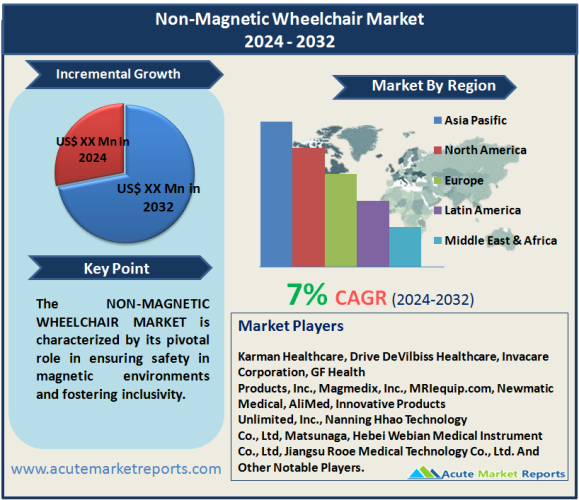
The non-magnetic wheelchair market is expected to grow at a CAGR of 7% during the forecast period of 2025 to 2033, driven by a commitment to safety in environments sensitive to magnetic interference. The non-magnetic wheelchair market is characterized by its pivotal role in ensuring safety in magnetic environments and fostering inclusivity. The restraint of cost implications emphasizes the need for a balanced approach to material advancements and affordability. The segmentation analysis provides insights into tailored solutions based on patient weight and magnetic field strength. The geographic trends highlight the global nature of the non-magnetic wheelchair industry, with unique opportunities and challenges in different regions. Competitive trends underscore the importance of innovation, market expansion, and user-centric design for industry leaders such as Karman Healthcare, Drive DeVilbiss Healthcare, and Invacare Corporation. As the non-magnetic wheelchair market continues to evolve, these factors will shape its trajectory from 2025 to 2033.
Safety in Magnetic Environments
The paramount driver in the non-magnetic wheelchair market is the critical need for safety in magnetic environments, particularly in healthcare settings with Magnetic Resonance Imaging (MRI) equipment. Non-magnetic wheelchairs ensure the safety of patients requiring mobility assistance when entering MRI rooms. The absence of magnetic components eliminates the risk of interference with the MRI's powerful magnetic field, preventing potential accidents and ensuring the well-being of patients. Real-world cases in healthcare facilities globally, where non-magnetic wheelchairs have become standard, demonstrate the essential role these devices play in promoting safety during medical procedures.
Enhanced Accessibility and Inclusivity
The emphasis on enhanced accessibility and inclusivity serves as a driver, expanding the adoption of non-magnetic wheelchairs across various settings. Beyond healthcare, non-magnetic wheelchairs address the needs of individuals with mobility challenges in environments where magnetic interference is a concern, such as research facilities or industrial spaces with sensitive equipment. The commitment to inclusivity is reflected in the growing demand from public spaces and institutions that prioritize accessibility for all individuals, irrespective of their reliance on mobility aids.

Advancements in Lightweight and Durable Materials
Advancements in the development of lightweight and durable materials represent a significant driver for non-magnetic wheelchairs. Innovations in materials, such as carbon fiber and titanium, contribute to the design of wheelchairs that are not only non-magnetic but also lightweight and robust. The use of these materials enhances the overall user experience by providing maneuverability and durability without compromising safety in magnetic environments. Case studies on the adoption of advanced materials by leading non-magnetic wheelchair manufacturers underscore the positive impact on user satisfaction and the market's growth.
Cost Implications of Advanced Materials
A substantial restraint in the non-magnetic wheelchair market is the cost implications associated with advanced materials used for non-magnetic properties. The incorporation of lightweight and durable materials, such as carbon fiber and titanium, in the manufacturing process adds to the overall production cost. Evidence from market studies indicates that the pricing of non-magnetic wheelchairs tends to be higher compared to traditional models, posing a challenge for widespread adoption, especially in regions with budget constraints. Mitigating this restraint requires a balance between material advancements and cost-effective manufacturing methods to ensure accessibility for a broader demographic.
Market Segmentation by Patient Weight: 100 kg to 150 kg Segment Dominates the Market
The non-magnetic wheelchair market is segmented by patient weight into Below 100 kg, 100 kg to 150 kg, and Above 150 kg categories. In 2024, the 100 kg to 150 kg segment led in both revenue and CAGR, reflecting the demand for sturdy and non-magnetic wheelchairs for individuals with higher weight requirements. However, during the forecast period from 2025 to 2033, the Above 150 kg segment is expected to exhibit the highest CAGR. This shift indicates an anticipated surge in demand for specialized non-magnetic wheelchairs catering to individuals with heavier weights, aligning with the industry's focus on providing tailored solutions.
Market Segmentation by Magnetic Field Strength: Up to 3T segment Dominates the Market
The market is segmented by magnetic field strength into Up to 3T and Up to 7T categories. In 2024, the Up to 3T segment led in both revenue and CAGR, reflecting the prevailing strength requirements for non-magnetic wheelchairs in environments with lower magnetic fields, such as standard MRI machines. However, during the forecast period from 2025 to 2033, the Up to 7T segment is expected to exhibit the highest CAGR. This shift indicates a growing demand for non-magnetic wheelchairs designed to withstand higher magnetic fields, addressing the evolving needs of healthcare facilities investing in advanced MRI technology.
APAC Remains the Global Leader
The non-magnetic wheelchair market exhibits diverse trends across regions, with specific areas experiencing higher CAGR and others contributing significantly to revenue. In the forecast period from 2025 to 2033, North America is anticipated to witness the highest CAGR. The region's advanced healthcare infrastructure, coupled with a strong focus on patient safety, is expected to drive the adoption of non-magnetic wheelchairs. However, Asia-Pacific is expected to maintain its position as the region with the highest revenue percentage, owing to the increasing awareness of safety standards and the growing emphasis on inclusive healthcare practices.
Market Competition to Intensify during the Forecast Period
The non-magnetic wheelchair market is marked by intense competition among top players, each employing unique strategies to maintain and enhance their market position. In 2024, leading companies such as Karman Healthcare, Drive DeVilbiss Healthcare, Invacare Corporation, GF Health Products, Inc., Magmedix, Inc., MRIequip.com, Newmatic Medical, AliMed, Innovative Products Unlimited, Inc., Nanning Hhao Technology Co., Ltd, Matsunaga, Hebei Webian Medical Instrument Co., Ltd, and Jiangsu Rooe Medical Technology Co., Ltd. demonstrated robust revenues. These industry leaders adopted strategies like innovation, market expansion, and user-centric design to solidify their market presence. A prevailing trend among key players is a continuous focus on innovation in material science and design. Key players invested significantly in researching and developing advanced materials that enhance the non-magnetic properties of wheelchairs while ensuring comfort and durability. This emphasis on innovation aims to address evolving user needs and stay ahead in a competitive market. Anticipated innovations from 2025 to 2033 are expected to focus on further optimizing the balance between non-magnetic features, weight considerations, and overall user experience.
Historical & Forecast Period
This study report represents analysis of each segment from 2023 to 2033 considering 2024 as the base year. Compounded Annual Growth Rate (CAGR) for each of the respective segments estimated for the forecast period of 2025 to 2033.
The current report comprises of quantitative market estimations for each micro market for every geographical region and qualitative market analysis such as micro and macro environment analysis, market trends, competitive intelligence, segment analysis, porters five force model, top winning strategies, top investment markets, emerging trends and technological analysis, case studies, strategic conclusions and recommendations and other key market insights.
Research Methodology
The complete research study was conducted in three phases, namely: secondary research, primary research, and expert panel review. key data point that enables the estimation of Non-Magnetic Wheelchair market are as follows:
Market forecast was performed through proprietary software that analyzes various qualitative and quantitative factors. Growth rate and CAGR were estimated through intensive secondary and primary research. Data triangulation across various data points provides accuracy across various analyzed market segments in the report. Application of both top down and bottom-up approach for validation of market estimation assures logical, methodical and mathematical consistency of the quantitative data.
| ATTRIBUTE | DETAILS |
|---|---|
| Research Period | 2023-2033 |
| Base Year | 2024 |
| Forecast Period | 2025-2033 |
| Historical Year | 2023 |
| Unit | USD Million |
| Segmentation | |
Patient Weight
| |
Magnetic Field Strength
| |
End-Use
| |
|
Region Segment (2023-2033; US$ Million)
|
Key questions answered in this report